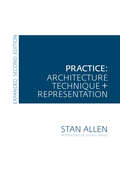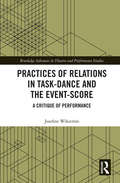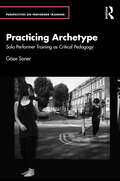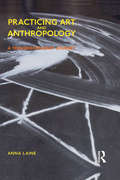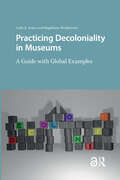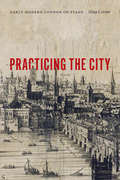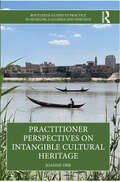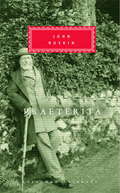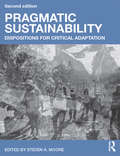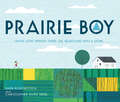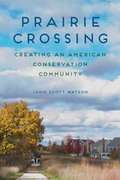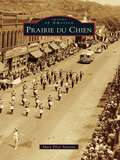- Table View
- List View
Practice as Research in the Arts (and Beyond): Principles, Processes, Contexts, Achievements
by Robin NelsonThis project addresses the contexts of Practice as Research and how to undertake it. This second iteration updates thinking and practices but sustains a direct and clear approach on how to become a practitioner-researcher. New features include an extension of range “beyond” the arts and a case for intra-disciplinarity in Practice Research as an influence in the formation of the “future university”. A comparison is made between Artistic Research and Practice Research recognizing that research through practices with being-doing-knowing is central to both. Acknowledging the current crisis in legitimation, a broad view is taken of how things might be known by an onto-epistemology for the twenty-first century foregrounding the bodymind but sustaining rationality and community by way of Other/other dialogic exchange. Perspectives from around the world in Part II offset the more Eurocentric emphasis in Part I.
Practice: Architecture, Technique and Representation
by Stan AllenConversant in contemporary theory and architectural history, Stan Allen argues that concepts in architecture are not imported from other disciplines, but emerge through the materials and procedures of architectural practice itself. Drawing on his own experience as a working architect, he examines the ways in which the tools available to the architect affect the design and production of buildings. This second edition includes revised essays together with previously unpublished work. Allen’s seminal piece on Field Conditions is included in this reworked, revised and redesigned volume. A compelling read for student and practitioner alike.
Practiceopolis: Stories From The Architectural Profession
by Yasser MegahedThis is a graphic novel about the contemporary architectural profession, in which it acts as the protagonist in the form of an imaginary city called Practiceopolis. The novel narrates quasi-realistic stories that exaggerate the architectural everyday and the tacit, in order to make them prominent and tangible. They depict and dramatise the value conflicts between the different cultures of practising architecture and between the architectural profession and other members of the building industry as political conflicts around the future of Practiceopolis. The book uses the metaphorical world of Practiceopolis to provoke big questions about everyday routines in the profession that practitioners may take for granted and to examine different ideologies at work among architects and other members of the construction industry. The novel ends in the tradition of dystopian worlds common in a certain strand of graphic novels. By vividly illustrating and narrating the critical issues he interrogates, the author has created a world which any architect, student or professional, will both instantly recognise and simultaneously reject, provoking the reader to challenge themselves and the profession at large. <P><P> <i>Advisory: Bookshare has learned that this book offers only partial accessibility. We have kept it in the collection because it is useful for some of our members. Benetech is actively working on projects to improve accessibility issues such as these.</i>
Practices Of Looking: An Introduction To Visual Culture (Third Edition)
by Lisa Cartwright Marita SturkenPractices of Looking, Third Edition, bridges visual, communication, media, and cultural studies to investigate how images and the activity of looking carry meaning within and between different arenas in everyday life. The third edition has been updated to represent the contemporary visual cultural landscape and includes topics like the increasingly rapid global circulation of media, the rise of design and DIY cultures, digital media art and activism, and challenges to photojournalism and news media. Challenging yet accessible, Practices of Looking, Third Edition, is ideal for courses across a range of disciplines.
Practices of Relations in Task-Dance and the Event-Score: A Critique of Performance (Routledge Advances in Theatre & Performance Studies)
by Josefine WikströmIn this study, Josefine Wikström challenges a concept of performance that makes no difference between art and non-art and argues for a new concept. This book confronts and criticises the way in which the dominating concept of performance has been used in Art Theory, Performance- and Dance Studies. Through an analysis of 1960s performance practices, Wikstrom focuses specifically on task-dance and event-score practices as well as through examination of the key philosophical concepts that are inseparable from such a concept of art, and are necessary for the reconstruction of a critical concept of performance such as: ‘practice’, experience’, ‘object’, ‘abstraction’ and ‘structure. This book will be of great interest to scholars, students and practitioner across dance, performance art, aesthetics and art theory.
Practicing Archetype: Solo Performer Training as Critical Pedagogy (Perspectives on Performer Training)
by Göze SanerPracticing Archetype addresses performer training, specifically the self-pedagogy of actors who train solo, on their own, as an independent learning process, an opportunity for embodied research, and a form of critical pedagogy.Joining the current critical and inclusive turn in performer training, the author reconfigures the psychophysical ‘work on self’ trope as ‘encounters with the self' and turns to the genre of solo performance, including examples of solo activism from recent years, for a deeper understanding into how the self always already implicates and relates to others. The space that opens in the dialogue between performer training and solo performance is negotiated around three key themes: presence, identity, and action. Using a methodology grounded in archetypal psychology alongside liberation psychology and decolonial feminist thought, and engaging the mythological figures Echo, Odysseus, and Sisyphus, the author reviews specific archetypal images that appear in key performer training texts and revisits well-known practices through the insights drawn from solo performance. Offering audio-guided exercises traditionally used in performer training as embodied forms of inquiry into the relationships between the individual and the various collectives surrounding her, the volume proposes that solo performer training can be mobilised for multiple interrelated objectives – creative, artistic, or professional development; critical, reflective, liberatory pedagogy; and spiritual, archetypal, imaginative encounters.The book speaks to all who are engaged in performer training – students and teachers, soloists and ensembles – as well as those with an interest in embodied forms of critical pedagogy or decolonial approaches to archetype.
Practicing Art and Anthropology: A Transdisciplinary Journey (Criminal Practice Ser.)
by Anna LainePracticing Art and Anthropology presents an in-depth exploration of transdisciplinary work in the expanding space between art and anthropology. Having trained and worked as an artist as well as an anthropologist, Anna Laine’s decades-long engagement in art practice, artistic research and anthropology provide her with a unique perspective on connections between the two fields, both in theory and in practice. Intertwining artistic and anthropological ways of working, Laine asks what it means to engage a transdisciplinary stance when academia requires a specific disciplinary belonging. In order to expand the methods of producing academic knowledge by going beyond conventional approaches to research, she draws on examples from her own work with Tamils in India and the UK to present an original take on how we can cross the boundaries between art and anthropology to reach multiple dimensions of understanding. Offering exceptional breadth and detail, Practicing Art and Anthropology provides a unique approach to the discussion. An important read for students and scholars in art and anthropology as well as artists and anyone interacting in the space in-between.
Practicing Decoloniality in Museums: A Guide with Global Examples
by Csilla Ariese Magdalena WróblewskaThe cry for decolonization has echoed throughout the museum world. Although perhaps most audibly heard in the case of ethnographic museums, many different types of museums have felt the need to engage in decolonial practices. Amidst those who have argued that an institution as deeply colonial as the museum cannot truly be decolonized, museum staff and museologists have been approaching the issue from different angles to practice decoloniality in any way they can. Practicing Decoloniality in Museums: A Guide with Global Examples collects a wide range of practices from museums whose audiences, often highly diverse, come together in sometimes contentious conversations about pasts and futures. Although there are no easy or uniform answers as to how best to deal with colonial pasts, this collection of practices functions as an accessible toolkit from which museum staff can choose in order to experiment with and implement methods according to their own needs and situations. The practices are divided thematically and include, among others, methods for decentering, improving transparency, and increasing inclusivity.
Practicing the City: Early Modern London on Stage
by Nina LevineIn late-sixteenth-century London, the commercial theaters undertook a novel experiment, fueling a fashion for plays that trafficked in the contemporary urban scene. But beyond the stage’s representing the everyday activities of the expanding metropolis, its unprecedented urban turn introduced a new dimension into theatrical experience, opening up a reflexive space within which an increasingly diverse population might begin to “practice” the city. In this, the London stage began to operate as a medium as well as a model for urban understanding.Practicing the City traces a range of local engagements, onstage and off, in which the city’s population came to practice new forms of urban sociability and belonging. With this practice, Levine suggests, city residents became more self-conscious about their place within the expanding metropolis and, in the process, began to experiment in new forms of collective association. Reading an array of materials, from Shakespeare and Middleton to plague bills and French-language manuals, Levine explores urban practices that push against the exclusions of civic tradition and look instead to the more fluid relations playing out in the disruptive encounters of urban plurality.
Practicing the Good: Desire and Boredom in Soviet Socialism (e-flux)
by Keti ChukhrovA philosophical consideration of Soviet Socialism that reveals the hidden desire for capitalism in contemporary anticapitalist discourse and theory This book, a philosophical consideration of Soviet socialism, is not meant simply to revisit the communist past; its aim, rather, is to witness certain zones where capitalism&’s domination is resisted—the zones of countercapitalist critique, civil society agencies, and theoretical provisions of emancipation or progress—and to inquire to what extent those zones are in fact permeated by unconscious capitalism and thus unwittingly affirm the capitalist condition. By means of the philosophical and politico-economical consideration of Soviet socialism of the 1960 and 1970s, this book manages to reveal the hidden desire for capitalism in contemporaneous anticapitalist discourse and theory. The research is marked by a broad cross-disciplinary approach based on political economy, philosophy, art theory, and cultural theory that redefines old Cold War and Slavic studies&’ views of the post-Stalinist years, as well as challenges the interpretations of this period of historical socialism in Western Marxist thought.
Practising Cultural Geographies: Essays in Honour of Rana P. B. Singh (Advances in 21st Century Human Settlements)
by Bharat Dahiya Arun K. Singh Ravi S. Singh Padma C. PoudelThis festschrift honours Prof. Rana P.B. Singh who has dedicated his life to teaching and conducting research on cultural geography with a ‘dweller Indian perspective’. The book focuses on the cultural geographies of India, and to an extent that of South Asia. It is a rich collection of 23 essays on the themes apprised by him, covering landscapes, religion, heritage, pilgrimage and tourism, and human settlements.
Practising Wood in Architecture: Connecting Design, Construction and Sustainability
by James Benedict Brown Francesco CamilliIn the stark light of the climate emergency, using wood instead of concrete, steel, or masonry is increasingly seen as a way of reducing the environmental impact of architecture and construction. More and more new buildings are showcasing innovative ways to work with wood. Wood can help architects achieve ambitious sustainability targets, including the United Nations’ Sustainable Development Goals.How can architects, student architects, and those in the construction industry better understand the qualities, characteristics, and possibilities of building with wood? Practising Wood in Architecture explores the methods, philosophies, and possibilities of contemporary teaching practices in architecture. This book explores how architecture students are learning to build with wood and interrogates the consequences for architectural practice.Based on original research conducted over two years, the book explores innovative projects that use wood in China, England, Finland, Germany, Mongolia, South Africa, and Switzerland. These case studies demonstrate the many advantages of wood, including its simplicity of use, its affordability, and its sustainability. The book focuses on ongoing initiatives that show the educational and professional impact of the use of wood in architecture and construction by students and professionals alike.
Practitioner Perspectives on Dance Research
by Gemma HarmanPractitioner Perspectives on Dance Research is a collection of accounts from scholars, educators, practitioners and makers that present an overview of key themes, arguments, and practices central to their individual research.Built upon conversations recorded as ResDance™ podcast episodes, this edited collection presents both theoretical discussions and first-hand insights into various research practices, engaging with both established and emergent ideas central to dance research. Whilst challenging current thinking, contributors from around the globe additionally offer reflections on ethics and practices of care, pedagogy and education, and the shifting perspectives on methodologies. By providing an accessible exploration of frequently employed approaches, this book illuminates the choices made and considerations taken in dance research practice.This interdisciplinary discourse presents a rich palette of perspectives, approaches and ideas and is ideal for students, researchers, academics and practitioners alike with an interest in the current state of dance, both in research and in practice.
Practitioner Perspectives on Intangible Cultural Heritage (Routledge Guides to Practice in Museums, Galleries and Heritage)
by Joanne OrrPractitioner Perspectives on Intangible Cultural Heritage provides an accessible introduction to the Intangible Cultural Heritage field. Summarising the major changes that have taken place over the last two decades, the book explores ongoing debates and changes in thinking about best practice. Drawing on the author’s own experience of operationalising the UNESCO 2003 Convention for the Safeguarding of Intangible Cultural Heritage in a variety of contexts, Orr also incorporates international case studies from practitioners and provides valuable insights about best practices. Demonstrating that the top-down, state-driven hierarchy for the safeguarding of heritage is starting to shift to a model of shared ownership and values driven by communities and practitioners, the book shows that the notion of the ‘expert’ is also diversifying to include other forms of transmission of traditional knowledge. Orr argues that these different perspectives provide a platform to enrich understanding and knowledge and create a stronger basis for the safeguarding of heritage - both intangible and tangible. Exploring some of the policy developments that have laid the foundations for the future involvement of community and practitioners in the global discourse, the book also suggests how practitioners can expand networks and contribute to the global discourse. Practitioner Perspectives on Intangible Cultural Heritage will appeal to museum curators and other heritage professionals, as well as students and academics engaged in the study of museums and heritage, art, and cultural policy and management.
Praeterita: Introduction by Timothy Hilton
by John RuskinAs a memoir elevated to the level of fine art, John Ruskin&’s Praeterita stands alongside The Education of Henry Adams and the confessions of Augustine, Rousseau, and Tolstoy. A luminous account of his childhood and youth, Praeterita is the last major work of the revolutionary nineteenth-century critic. Written in the lucid intervals between the bouts of dementia that haunted his final years, Praeterita tells the story of Ruskin&’s early life—the formation of his taste and intellect through education, travels in Europe, and encounters with great works of art and artists. In abandoning the traditional linear mode of autobiography, Ruskin opened up the form and was an important influence on Proust. He also provided a vivid, detailed portrait of pre-Victorian and Victorian England that is as indispensable an account of its era as Samuel Pepys&’s diary is of England in the seventeenth century. This edition of Praeterita is accompanied by Dilecta, Ruskin&’s own selection from his letters, diaries, and other writings. In these more private writings we get a fascinating glimpse of genius as it flickers in and out of madness. Together these two works illuminate the life and mind of a towering intellect who left an extraordinary mark on the history of aesthetics and culture, and on the very course of autobiography. With a new Introduction by Tim Hilton
Pragmatic Spatial Planning: Practial Theory for Professionals
by Charles HochInstead of seeking theory to justify practical professional judgments this book describes how professionals can and should use theory to guide these judgments. Professional spatial planning in the US, and globally, continues to suffer from a weak conceptual grasp of its own practice. Practitioners routinely recognize the value and wisdom of practical judgment finely attuned to context, nuance and complexity; but later offer banal testimony and glib stories of ‘just so’ best-practice discrediting the ambiguity of their own experience. The chapters in this book provide a vocabulary tailored to the conventions of practical judgment, challenging students and practitioners to treat professional expertise as work in progress rather than ‘best’ practice. Instead of seeking theory to justify practical professional judgments, Hoch describes how professionals can and should use theory to guide these judgments. The pragmatist plan helps cope with complexity rather than control it, making it invaluable in the anyone’s pursuit of a planning career. This book will appeal to a wide cross section of students and scholars, especially those working in urban planning, public policy, and government.
Pragmatic Sustainability: Dispositions for Critical Adaptation
by Steven A. MooreThis second edition of Pragmatic Sustainability proposes a pragmatic, discursive and pluralistic approach to thinking about sustainability.. Rather than suggesting a single solution to the problem of how to live sustainably, this collection discusses broader approaches to social and environmental change. Eight continuing authors and seven new ones adjust their dispositions toward rapidly changing and still unsustainable conditions, forging agreements and disagreements on five overlapping themes: the Grounds for Sustainability; the critique of Technological Culture; the need to conceive of Sustainability in Place; in Cities; finally asking how should we reimagine the fraught relationship between Civil Society, Industry and Regulation? Editor Steven A. Moore asks how a set of ideas now more than a century old remains relevant. A partial answer can be found in reconstructing the very modern ideas confronted by those who came to call themselves Pragmatists at the beginning of the twentieth century—evolution, ecology and design. Moore argues that we have yet to develop dispositions in theory and practice that critically integrate these ideas into sustainable development. In sum, this new edition provides a fresh and hopeful look at the wicked problems deliberated by almost anyone engaged in adapting to the always changing conditions of the built world.
Pragmatist Philosophy and Dance: Interdisciplinary Dance Research in the American South (Performance Philosophy)
by Eric MullisThis book investigates how Pragmatist philosophy as a philosophical method contributes to the understanding and practice of interdisciplinary dance research. It uses the author's own practice-based research project, Later Rain, to illustrate this. Later Rain is a post-dramatic dance theater work that engages primarily with issues in the philosophy of religion and socio-political philosophy. It focuses on ecstatic states that arise in Appalachian charismatic Pentecostal church services, states characterized by dancing, paroxysms, shouting, and speaking in tongues (glossolalia). Research for this work is interdisciplinary as it draws on studio practice, ethnographic field work, cultural history, Pentecostal history and theology, folk aesthetics, anthropological understandings of ecstatic religious rituals, and dance history regarding acclaimed works that have sought to present aspects of religious ecstasy on stage; Doris Humphrey's The Shakers (1931), Mark Godden’s Angels in the Architecture (2012), Martha Clarke’s Angel Reapers (2015) and Ralph Lemon’s Geography trilogy (2005). The project thereby demonstrates a process model of dance philosophy, showing how philosophy and dance artistry intertwine in a specific creative process.
Prague, Capital of the Twentieth Century: A Surrealist History
by Derek SayerThe story of modernity told through a cultural history of twentieth-century PragueSetting out to recover the roots of modernity in the boulevards, interiors, and arcades of the "city of light," Walter Benjamin dubbed Paris "the capital of the nineteenth century." In this eagerly anticipated sequel to his acclaimed Coasts of Bohemia: A Czech History, Derek Sayer argues that Prague could well be seen as the capital of the much darker twentieth century. Ranging across twentieth-century Prague's astonishingly vibrant and always surprising human landscape, this richly illustrated cultural history describes how the city has experienced (and suffered) more ways of being modern than perhaps any other metropolis.Located at the crossroads of struggles between democratic, communist, and fascist visions of the modern world, twentieth-century Prague witnessed revolutions and invasions, national liberation and ethnic cleansing, the Holocaust, show trials, and snuffed-out dreams of "socialism with a human face." Yet between the wars, when Prague was the capital of Europe's most easterly parliamentary democracy, it was also a hotbed of artistic and architectural modernism, and a center of surrealism second only to Paris.Focusing on these years, Sayer explores Prague's spectacular modern buildings, monuments, paintings, books, films, operas, exhibitions, and much more. A place where the utopian fantasies of the century repeatedly unraveled, Prague was tailor-made for surrealist André Breton's "black humor," and Sayer discusses the way the city produced unrivaled connoisseurs of grim comedy, from Franz Kafka and Jaroslav Hasek to Milan Kundera and Václav Havel. A masterful and unforgettable account of a city where an idling flaneur could just as easily be a secret policeman, this book vividly shows why Prague can teach us so much about the twentieth century and what made us who we are.
Prairie Boy: Frank Lloyd Wright Turns The Heartland Into A Home
by Barb RosenstockA Notable Social Studies Trade Book for Young People * A NSTA/CBC Best STEM BookFrank Lloyd Wright, a young boy from the prairie, becomes America's first world-famous architect in this inspirational nonfiction picture book introducing organic architecture -- a style he created based on the relationship between buildings and the natural world -- which transformed the American home.Frank Lloyd Wright loved the Wisconsin prairie where he was born, with its wide-open sky and waves of tall grass. As his family moved across the United States, young Frank found his own home in shapes: rectangles, triangles, half-moons, and circles. When he returned to his beloved prairie, Frank pursued a career in architecture. But he didn't think the Victorian-era homes found there fit the prairie landscape. Using his knowledge and love of shapes, Frank created houses more organic to the land. He redesigned the American home inside and out, developing a truly unique architecture style that celebrated the country's landscape and lifestyle. Author Barb Rosenstock and artist Christopher Silas Neal explore the early life and creative genius of architect Frank Lloyd Wright, highlighting his passion, imagination, and ingenuity.
Prairie Crossing: Creating an American Conservation Community
by John Scott WatsonCarved out of century-old farmland near Chicago, the Prairie Crossing development is a novel experiment in urban public policy that preserves 69 percent of the land as open space. The for-profit project has set out to do nothing less than use access to nature as a means to challenge America's failed culture of suburban sprawl. The first comprehensive look at an American conservation community, Prairie Crossing goes beyond windmills and nest boxes to examine an effort to connect adults to the land while creating a healthy and humane setting for raising a new generation attuned to nature. John Scott Watson places Prairie Crossing within the wider context of suburban planning, revealing how two first-time developers implemented a visionary new land ethic that saved green space by building on it. The remarkable achievements include a high rate of resident civic participation, the reestablishment of a thriving prairie ecosystem, the reintroduction of endangered and threatened species, and improved water and air quality. Yet, as Watson shows, considerations like economic uncertainty, lack of racial and class diversity, and politics have challenged, and continue to challenge, Prairie Crossing and its residents.
Prairie Man: My Little House Life & Beyond
by Dean ButlerUSA TODAY BestsellerPUBLISHERS WEEKLY BestsellerAn illuminating, insider&’s journey through the world of Little House on the Prairie and beyond, from Dean Butler, who starred as Almanzo Wilder, the man Laura &“Half Pint&” Ingalls married—on the iconic show still beloved by millions of fans as it reaches its 50th anniversary.With a foreword from Melissa Gilbert (Laura) and Alison Arngrim (Nellie)! Cast just before his twenty-third birthday, Dean Butler joined Little House on the Prairie halfway through its run, gaining instant celebrity and fans&’ enduring affection. Ironically, when the late, great Michael Landon remarked that Little House would outlive everyone involved in making it, Butler deemed it unlikely. Yet for four decades and counting, Butler has been defined in the public eye as Almanzo Wilder—a role he views as the great gift of his life. Butler had been cast as a romantic lead before, notably in the made-for-TV movie of Judy Blume&’s Forever, opposite Stephanie Zimbalist. But Little House was, and remains, one of the most treasured shows in television history. As the eventual husband of Laura &“Half-pint&” Ingalls—and the man who would share actress Melissa Gilbert&’s first real-life romantic kiss—Butler landed as a central figure for the show&’s devoted fans. Now, with wit and candor, Butler recounts his passage through the Prairie, sharing stories and anecdotes of the remarkable cast who were his on-screen family. But that was merely the beginning of a diverse career that includes Broadway runs and roles on two other classic shows—Moondoggie in The New Gidget and Buffy&’s ne&’er-do-well father, Hank, in Buffy the Vampire Slayer. Coming of age during a golden era of entertainment, Butler has evolved along with it, and today enjoys success and fulfillment as a director and producer—notably of NBC Golf&’s Feherty—while remaining deeply loyal to Little House. The warmth, heart, and decency that fans of Laura and Almanzo fell in love with on Little House echo through this uplifting memoir, a story, in Butler&’s words, about &“good luck, good television, and the very good—if gloriously imperfect—people who made it so.&”
Prairie Quilts: Projects for the Home Inspired by the Life and Times of Laura Ingalls Wilder
by Johanna WilsonInspired by the beloved stories of Laura Ingalls Wilder, Prairie Quilts & Decor provides a variety of quilt patterns and stitching projects reminiscent of pioneer life as it was experienced on the Midwestern frontier in the 1800s. Expertly guided by author Johanna Wilson, enthusiasts can now preserve the tales of a lost era in American history by sharing with the generations the experience of quilting as remembered on the television series Little House on the Prairie. From the Goose in the Pond wall hanging to the Memories of Laura quilt, and from the Single Wedding Ring pillow to the Pinwheel baby quilt, more than 20 projects capture a lasting picture of pioneer life. Assisting beginners and enhancing the efforts of skilled quilters, this new book includes a featured section with general quilting tips and techniques. Clear instructions and detailed diagrams enable a fulfilling creative experience for both the novice and experienced!
Prairie Style Weddings: Rustic and Romantic Farm, Woodland, and Garden Celebrations
by Fifi O'NeillGet ideas for a rustic-themed bridal shower, rehearsal dinner, ceremony, or reception, plus ten DIY projects to add a homespun touch to your event.Rustic barns and gardens are popular settings for the intimate, personalized weddings that are among today’s top trends. Stylist Fifi O’Neill knows how to transform such venues into gorgeous “prairie style” celebrations that seamlessly blend ruggedness and elegance. This beautifully illustrated look-book with more than 150 photographs is filled with unique ideas for planning the perfect bridal shower, rehearsal dinner, ceremony, and reception. From a cheery garden-shed party to a dinner set amid a lush cornfield, Prairie-Style Weddings shows how to achieve an effortless look that is rich in personality and bursting with charm. Ten simple DIY projects add a homespun touch to any wedding event.
Prairie du Chien
by Mary Elise AntioneJust above the confluence of the Wisconsin and Mississippi Rivers lies a 9-mile prairie whose beauty and location have long drawn people to its expanse. At this traditional gathering place of Native Americans, French explorers and fur traders stored trade goods and celebrated on the prairie, in time building homes at la Prairie des Chiens. American soldiers constructed a fort here, at the entrance to the upper Mississippi Valley, to secure the region for settlement. Wave upon wave of people arrived in Prairie du Chien by steamboat and railroad, and by 1900, a bustling city had spread across the plain. But the French heritage and majestic beauty of the river endured. After World War I, tourists came to drift along the banks of the Mississippi, climb the steep bluffs surrounding the prairie, and sample the Friday night fish fries. Wisconsin's second-oldest community, Prairie du Chien retains the attraction that drew the first explorers to its shores.

